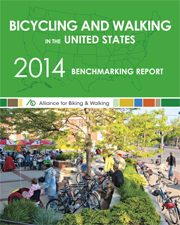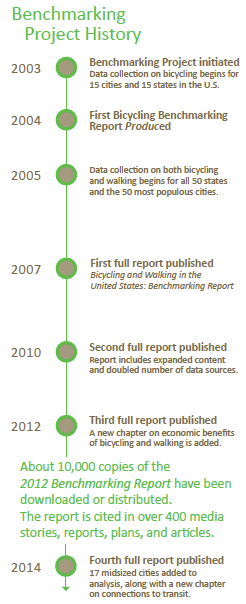 |
| Buy a copy of the 2014 Benchmarking Report |
Take a moment to travel backwards in biking and walking advocacy history to 2007.
It was less than a decade ago, but the conversation about transportation was completely different from today. Only 16 states in the U.S. had a published goal to increase bicycling and walking. Sharrows were cutting edge bicycle infrastructure. Only a couple of U.S. cities had experimented with community bike programs. The term "bike share" would have drawn blank stares at a dinner party.
Now fast forward to 2014.
City and state leaders are competing for bike- and walk-friendly status, prioritizing slices of city budgets for protected bike lanes and walkable transit stops, and enthusiastically lending support to sophisticated bike sharing systems. People love biking and walking, and local active transportation advocacy organizations are growing to help harness and amplify citizen demand for walkable, bikeable places.
Our movement has come a long way. But it would be much harder to know just how far we've come without hard data.
That's why the Alliance for Biking & Walking creates the Benchmarking Report – an ongoing project to collect data on bicycling and walking, measure progress and evaluate results, and support efforts to increase biking and walking.
 The Alliance's Benchmarking Project began in 2003 because leaders of state and local biking and walking advocacy organizations recognized the need to measure progress on bicycling and walking intitiatives. Without hard data to measure results, Alliance organizations couldn't be sure how much progress was being made – and what approaches proved most successful for building great streets.
The Alliance's Benchmarking Project began in 2003 because leaders of state and local biking and walking advocacy organizations recognized the need to measure progress on bicycling and walking intitiatives. Without hard data to measure results, Alliance organizations couldn't be sure how much progress was being made – and what approaches proved most successful for building great streets.
At first, the project was just about bicycling – and the Alliance sported a purple logo and went by its old name, the Thunderhead Alliance. Back in 2003, the Alliance jump-started a pilot benchmarking effort with 15 cities and states. This was the first time that advocates in our movement pulled combined data from disparate federal sources like the Census, National Household Travel Survey, and Fatality Analysis Reporting System with local and state surveys to compare data like bike modeshare, miles of bike facilities, and bicyclist fatalities across cities and states.
The resulting 2004 draft Benchmarking Report paved the way for the research methods that we still use today.
The Alliance published the first full Benchmarking Report in August of 2007 in partnership with the Centers for Disease Control and Prevention, with additional support from Planet Bike and Bikes Belong (now PeopleForBikes). This time, the report included data from all 50 states and the 50 most populous cities and reported on both bicycling and walking.
Through updated reports in 2010, 2012, and 2014, the Benchmarking Report provides a consistently reliable snapshot of bicycling and walking in the United States. Buy the 2014 Benchmarking Report here.
The goals of the Alliance's Benchmarking project are:
- Promote data collection and availability. Data on biking and walking are often scattered and not easily accessible. We compile reliable nationwide data in one place and conduct state and local surveys to create a comprehensive picture of active transportation in the U.S.
- Measure progress and evaluate results. Tracking progress over time helps communities gauge the results of their efforts to determine what works and what doesn't.
- Support efforts to increase bicycling and walking. As a coalition of state and local advocacy organizations, we support efforts by public servants and advocates to increase active transportation in their communities. We strive to make the Report useful for those who work to create more bikeable, walkable communities.
- Make the health connection. Physical activity can improve a person's health at any weight – and building everyday activity back into Americans' daily routines can help us combat preventable diseases like diabetes and heart disease. We strive to examine relationships between health and active transportation to help communities prioritize public health.
- Strengthen the Alliance network. We seek to bolster our network of biking and walking advocacy organizations by providing the data they need to evaluate successes, prove results, and gain prominence in their communities. The Benchmarking Report is a tool for highlighting state and local achievements while also pinpointing the areas that need improvement.
Explore the massive range of data within the Benchmarking Report for yourself – purchase a copy of the 2014 Benchmarking Report here.
If you're glad that the biking and walking movement has grown a ton since 2007, please consider sharing this.
| Share on Facebook |

